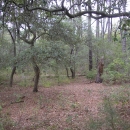About Us
Alligator River National Wildlife Refuge is located on the Albemarle Peninsula in eastern North Carolina. The refuge was established in 1984 to protect the rare pocosin wetlands and their associated wildlife. Pocosin wetlands grow on thick layers of peat and have stunted, shrubby vegetation. In addition to pocosins, the refuge also protects swamp forest and is fringed with marsh. The vast protected area supports large populations of black bear, wintering waterfowl, river otter, and other wildlife species. In addition, the refuge is one of the only places in the world where you may see endangered red wolves in the wild.
Our Mission
Vision
Alligator River National Wildlife Refuge’s unique wetland habitats will become more critical for many wildlife, fish, and plants as eastern North Carolina is developed. Refuge habitats will be managed, enhanced, and restored for optimal diversity of wildlife, fish, and plants. Healthy and viable populations of threatened and endangered species, and other wildlife, fish, and plants will be managed and conserved. People will visit this refuge in greater numbers to witness its subtle beauty and to seize the opportunity to explore. Refuge staff and volunteers will assume a greater role in educating the visiting public to ensure that biological integrity is maintained and that people have a safe, pleasant and educational experience. Visitors will be encouraged to participate in compatible, wildlife-dependent recreational activities. The visitor center will serve as a gateway, not only for adventure into Alligator River National Wildlife Refuge, but also to encourage the many visitors to the Outer Banks to venture inland to other local national wildlife refuges. There will be a growing responsibility to reach out to local and national communities about the refuge’s importance as a valuable piece of the puzzle that connects all wildlife habitats together. Working with others, the refuge’s staff and volunteers will adaptively manage the refuge’s natural resources and create in this wild place a legacy of fish, wildlife, and plants for future visitors to experience, enjoy, and cherish.
Refuge Purposes
Each unit of the National Wildlife Refuge System is established to serve a statutory purpose that targets the conservation of native species dependent on its lands and waters. All activities on those acres are reviewed for compatibility with this statutory purpose.
The purpose of Alligator River National Wildlife Refuge is to protect and conserve migratory birds and other wildlife resources through the protection of wetlands, in accordance with the following:
“...for the development, advancement, management, conservation, and protection of fish and wildlife resources...” 16 U.S.C. Sec 742f(a)4 (Fish and Wildlife Act of 1956).
“...for the benefit of the United States Fish and Wildlife Service, in performing its activities and services..." 16 U.S.C. Sec. 742f(b)1 (Fish and Wildlife Act of 1956).
“...suitable for (1) incidental take of fish and wildlife-oriented recreational development, (2) the protection of natural resources, (3) the conservation of endangered species…” 16 U.S.C., Sec. 460k-1 (Refuge Recreation Act of 1952).
“...the Secretary…may accept and use…real…property. Such acceptance may be accomplished under the terms and conditions of restrictive covenants imposed by donors…” 16 U.S.C., Sec. 460k-2; 16 U.S.C., Sec. 460k-460k-4 (Refuge Recreation Act of 1952).
“...conservation, management, and restoration of fish, wildlife, and plant resources and their habitats within the United States for the benefit of present and future generations of Americans” 16 U.S.C., Sec. 668dd(a)(2) (National Wildlife Refuge System Administration Act of 1966).
“…for the conservation of the wetlands of the Nation in order to maintain the public benefits they provide and to help fulfill international obligations contained in various migratory bird treaties and conventions…” 16 U.S.C., Sec. 3901 (b) 100 Stat. 1583 (Emergency Wetland Resources Act of 1986).
Other Facilities in this Complex
A National Wildlife Refuge Complex is an administrative grouping of two or more refuges, wildlife management areas or other refuge conservation areas that are primarily managed from a central office location. Refuges are grouped into a complex structure structure
Something temporarily or permanently constructed, built, or placed; and constructed of natural or manufactured parts including, but not limited to, a building, shed, cabin, porch, bridge, walkway, stair steps, sign, landing, platform, dock, rack, fence, telecommunication device, antennae, fish cleaning table, satellite dish/mount, or well head.
Learn more about structure because they occur in a similar ecological region, such as a watershed or specific habitat type, and have a related purpose and management needs.
There are 9 national wildlife refuges in the Coastal North Carolina National Wildlife Refuges Complex. The Project Leader for the Complex supervises the Refuge Managers who are responsible for managing these refuges. However, there are five distinct and separate administrative offices. Alligator River and Pea Island National Wildlife Refuges are administered from the Alligator River National Wildlife Refuge Headquarters in Manteo, NC. An administrative office at the Mackay Island National Wildlife Refuge Headquarters in Knotts Island, NC manages both Mackay Island and Currituck National Wildlife Refuges. An office at Mattamuskeet National Wildlife Refuge administers Mattamuskeet, Swanquarter, and Cedar Island National Wildlife Refuges. Pocosin Lakes National Wildlife Refuge, Roanoke River National Wildlife Refuge, Great Dismal Swamp National Wildlife Refuge, Back Bay National Wildlife Refuge, and Edenton National Fish Hatchery each have separate administrative offices.
All of the Coastal North Carolina National Wildlife Refuges, Great Dismal Swamp National Wildlife Refuge, Back Bay National Wildlife Refuge, and Edenton National Fish Hatchery are open to public visits for nature-based recreational enjoyment. Priority public uses are hunting, fishing, wildlife observation, wildlife photography, environmental education, and interpretation.





